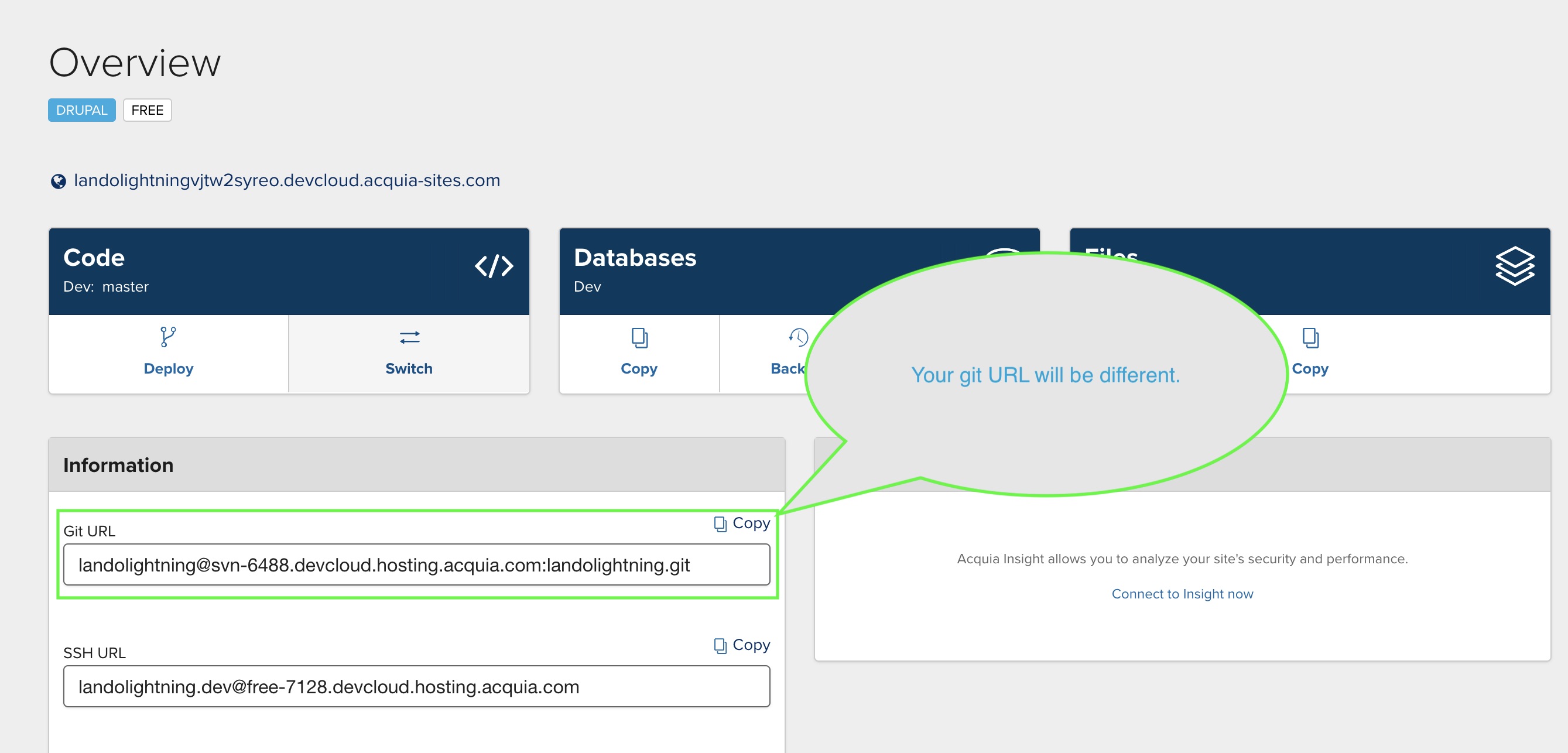# Introduction
Acquia BLT (opens new window) is the Acquia Build Launch Tool (BLT). It can be a paradigm shift for many Drupal developers, but the idea is that your production environment is an artifact of development (opens new window). In brief, that is to say you need different things in your dev environment than what you need to run the production web application. BLT helps us embody this workflow by providing a build and deploy pipeline where we have all the tools we need and love in dev and with a simple lando blt deploy command the production artifact is generated, sanitized, and delivered to the Acquia Cloud. Awesome!
# Init the Lando BLT Lightning App
Make a directory for your new app and cd into it. Then, use the lando init command to get going:
lando init -r drupal8
Edit the resulting .lando.yml file and add the tooling key. This will make Lando aware of the blt command inside the app.
name: lando-lightning
recipe: drupal8
config:
webroot: lightning/docroot
tooling:
blt:
service: appserver
cmd: /usr/bin/blt
Start the app.
lando start
# Get a BLT Lightning App Codebase
Install a BLT Lightning project with composer.
lando composer create-project --no-interaction acquia/blt-project lightning
Change directories into the new lightning app.
cd lightning
Tell BLT about your Acquia Cloud app by setting the machine_name in the blt/project.yml file to match the machine_name of your Acquia app from the dashboard. Also, make sure to use the lightning profile by checking that the line name: lightning indicates the lightning distribution. It should by default, but if it does not you should change it.
project:
machine_name: landolightning
prefix: BLT
human_name: 'Lando BLT Lightning'
profile:
name: lightning
Hook up the Lando command we defined earlier in .lando.yml to the blt executable cli tool wyth a symlink:
lando ssh -u root -c "ln -s /app/lightning/vendor/acquia/blt/bin/blt /usr/bin/blt"
Check that Lando has access to run blt commands
lando blt help
You should see help output similar to:
decoupled (master) $ lando blt help
[warning] The xDebug extension is loaded. This will significantly decrease performance.
Usage:
help [options] [--] <command> [<command_name>]
Arguments:
command The command to execute
command_name The command name [default: "help"]
Options:
--format=FORMAT The output format (txt, xml, json, or md) [default: "txt"]
--raw To output raw command help
-h, --help Display this help message
-q, --quiet Do not output any message
-V, --version Display this application version
--ansi Force ANSI output
--no-ansi Disable ANSI output
-n, --no-interaction Do not ask any interactive question
-y, --yes Answer all confirmations with "yes"
-D, --define=DEFINE Define a configuration item value. (multiple values allowed)
-v|vv|vvv, --verbose Increase the verbosity of messages: 1 for normal output, 2 for more verbose output and 3 for debug
Help:
The help command displays help for a given command:
php /usr/bin/blt help list
You can also output the help in other formats by using the --format option:
php /usr/bin/blt help --format=xml list
To display the list of available commands, please use the list command.
# Install Drupal via blt
First, you have to change your database credentials. Open the file sites/default/settings/local.settings.php and update the creds like so:
/**
* Database configuration.
*/
$databases = array(
'default' =>
array(
'default' =>
array(
'database' => 'drupal8',
'username' => 'drupal8',
'password' => 'drupal8',
'host' => 'database',
'port' => '3306',
'namespace' => 'Drupal\\Core\\Database\\Driver\\mysql',
'driver' => 'mysql',
'prefix' => '',
),
),
);
Now that the database creds are set, we are ready to install the site. Run:
lando blt setup
During this step, drush will output a random username and password. Make note of those so you can use them to login to your new site, or you can login with lando drush uli to generate a one-time login link.
# Pro Tip
Create or edit the sites/default/local.drushrc.php file to get nice URL output from drush uli add this line:
$options['uri'] = "https://[LANDO-BLT].lndo.site";
Replace LANDO-BLT with the name of your app from the .lando.yml file.
# Configure BLT project.yml to Deploy to Acquia Cloud
Open the lightning/blt/project.yml file. Find the git key and add your Acquia git URL as a remote. Should look similar to this:
git:
default_branch: master
remotes:
- landolightning@svn-6488.devcloud.hosting.acquia.com:landolightning.git
Replace the git URL with a URL from your Acquia Cloud dashboard.

Acquia Cloud Dashboard Screenshot
# Deploy to Acquia Cloud
Now deploying to Acquia cloud is as simple as one command: lando blt deploy. This will run the build process, generate your production artifact, and push it to Acquia Cloud! 💯;
It will prompt you for a few options:
lightning (master) $ lando blt deploy
[warning] The xDebug extension is loaded. This will significantly decrease performance.
Typically, you would only create a tag if you currently have a tag checked out on your source repository.
Would you like to create a tag? (y/n) n
Enter a valid commit message [Adding memow module to landolightning.]
Enter the branch name for the deployment artifact [master-build] master
By default the Acquia Cloud dev instance is on the master branch so in the above prompts you specify that (if you want it to deploy out to that environment).
# Some Useful BLT Commands at your Finger Tips
Try any or all of these commands:
# list targets
lando blt
# validate code via phpcs, php lint, composer validate, etc.
lando blt validate
# run phpunit tests
lando blt tests:phpunit
# ssh into vm & run behat tests
lando blt tests:behat
# diagnose issues
lando blt doctor
# download & require a new project
lando composer require drupal/ctools:^8.3.0
# build a deployment artifact
lando blt deploy:build
# build artifact and deploy to git.remotes
lando blt deploy
# update BLT
lando composer update acquia/blt --with-dependencies
Visit the Acquia BLT Documentation (opens new window) to see the full power of the BLT system.
# Conclusion
⚡ Selecting the right tools can make your life easier; your app more stable; your clients happier. Everyone is a winner! Combine the best-in-breed tools from local dev with Lando to powerful scalable hosting with Acquia Cloud. ⚡
